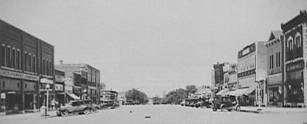Herington History

Herington, Kansas is located in the southeast corner of Dickinson County and is the hub of the Tri-County area for Dickinson, Morris and Marion Counties. Herington is associated with Father Juan de Padilla, Kansas' first Christian martyr who accompanied the Coronado expedition of 1541. He lost his life in this area trying to convert the local Indians. A monument was erected in the North City Park of Herington to commemorate the event. The park was later named Father Padilla Park.
The City of Herington was named after it's founder, Monroe Davis Herington. He was born April 23, 1843 in Lenawee County, Michigan. He died April 13, 1932 in Herington, Kansas. His name at birth was Davis Monroe Herrington, but he always wanted to be a doctor so he called himself M.D. and dropped the second "r" in his last name, Herington.
There were German immigrants who settled along Lyon Creek, three miles southwest of Herington in September of 1859. Tonkawa Indians of the Kansa tribe were in the area but were few and were friendly. The Kaw and the Cheyenne tribes passed through the area on hunting parties as well as a few other tribes.
The United States government had given this site of Herington to the railroads as an inducement to build into new territory. Sales were handled for the railroad by the land office of the Union Trust Company of New York at Emporia, Kansas.
On October 31, 1879, our locality was bought from the Missouri, Kansas and Texas Railway Company (MKT) by George M. Noble and his wife, Eva. Nothing is known of Mr. Noble, except that he started a cattle ranch and on May 8, 1880 they sold the land to Count Charles E. Alioth and his wife, Anna. Alioth was said to be the son of a Swiss nobleman. The cattle ranch operation was expanded.
Mr. Herington saw an ad in the Bloomington, Illinois newspaper. He wanted to trade his Illinois businesses for land in the west. He visited the Alioth ranch in July, 1880 and arrangements were made for him to buy the 1,400 acre ranch. There were no near-by cities. Closest neighbors were the German, and later the Scottish immigrants southwest, and to the northwest of the ranch. Mr. Herington received a warranty deed from the Alioths on August 2, 1880. Mr. Herington, a widower, had married Jan Waters Parkin, a widow, on June 17, 1880. He and his family moved to the ranch March 4, 1881.
In 1887, Mr. Herington successfully got the Chicago, Kansas and Nebraska Railroad to build through Herington. He gave the land and right-of-way for Herington to become a division point with shops, two round houses, freight house, bridge yards, telegraph office and many other buildings. He furnished the limestone for the freight house, and for a two story depot that was 28 x 66 feet and later enlarged to 28 x 105 feet.
During World War II, Herington Army Air Field was one of only two fields that processed heavy bombardment crews and equipment staging to the coasts for overseas duty. The field was later turned over to the City of Herington and is currently used as a municipal airport and industrial site.

